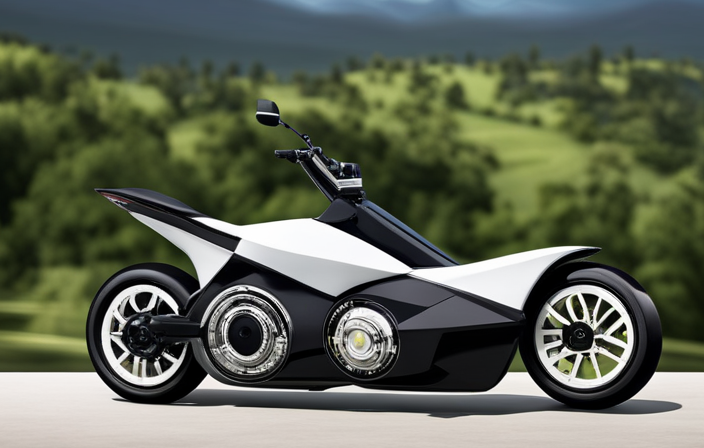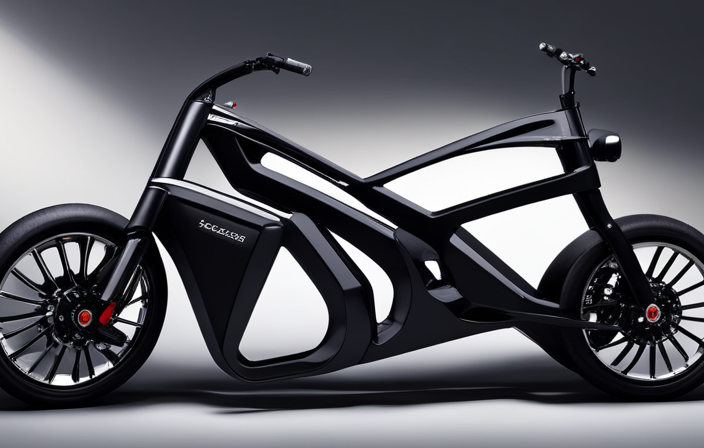Have you ever been curious about the longevity of an electric bike’s battery? Let me assure you, the answer isn’t as clear-cut as you might think.
The lifespan of an electric bike battery depends on various factors, such as proper care, usage management, and battery capacity.
In this article, we will delve into the intricacies of battery longevity, debunking myths along the way, and providing you with essential information to choose the right battery for your electric bike.
So, let’s get started and uncover the truth behind electric bike battery lifespan.
Key Takeaways
- Proper care and maintenance, including storing the battery in a cool, dry place and avoiding extreme temperatures, can help extend the lifespan of an electric bike battery.
- Managing battery usage by avoiding fully charging or depleting it for extended periods and charging it to around 80% for long-term storage can contribute to a longer battery lifespan.
- Understanding battery capacity and range is important, as factors such as battery capacity, motor power, terrain, and rider weight can affect the riding distance. Increasing battery capacity can extend the riding distance.
- Maximizing battery efficiency through the use of pedal assist, choosing lower power settings when assistance is not needed, and unplugging the charger when the battery is fully charged can help prolong the battery lifespan. Regular maintenance and inspections are also recommended.
Understanding Battery Lifespan
The lifespan of an electric bike battery can vary depending on factors such as usage patterns and maintenance practices. It is important to understand that the lifespan of a battery is not fixed and can be influenced by how it is used and cared for.
When it comes to battery disposal options, it is crucial to choose the right method. Many cities have battery recycling programs in place, which allow you to dispose of your old electric bike battery in an environmentally-friendly manner. These programs ensure that the battery is properly recycled and the materials are reused.
To ensure a longer lifespan for your electric bike battery, proper care and maintenance are essential. This includes regularly charging the battery, storing it in a cool and dry place, and avoiding extreme temperatures.
By following these guidelines, you can maximize the lifespan of your electric bike battery and reduce the need for frequent replacements.
Proper Battery Care and Maintenance
With proper care and maintenance, your e-bike battery can keep on going like the Energizer Bunny.
When it comes to battery storage, it’s important to keep your e-bike battery in a cool, dry place. Extreme temperatures can negatively impact its lifespan, so avoid leaving it in direct sunlight or freezing conditions.
Additionally, it’s crucial to charge your battery properly. Avoid overcharging it by unplugging it once it reaches full capacity. It’s also recommended to charge the battery after each use, rather than waiting for it to completely drain. This helps maintain the battery’s overall health and longevity.
By following these guidelines for battery storage and charging, you can ensure that your e-bike battery lasts for a long time.
Now, let’s move on to managing battery usage and maximizing its efficiency.
Managing Battery Usage
To make the most of your e-bike’s battery, it’s essential to efficiently manage its usage. Proper battery storage is crucial for maximizing battery lifespan. When not in use, store your battery in a cool and dry place, away from extreme temperatures and direct sunlight. Avoid keeping it fully charged or completely depleted for extended periods, as this can reduce its overall capacity.
It’s recommended to charge the battery to around 80% and store it in this state if you won’t be using the e-bike for an extended period. Additionally, avoid exposing the battery to moisture or water, as it can damage the cells. By following these guidelines, you can ensure that your e-bike’s battery stays in optimal condition, maximizing its lifespan.
Looking ahead to the next section about battery capacity and range, it’s important to understand how these factors play a role in overall battery performance.
Battery Capacity and Range
When it comes to electric bike batteries, understanding battery capacity and range is crucial. Calculating battery range involves considering factors such as battery capacity, motor power, terrain, and rider weight.
These factors can significantly affect the range of an electric bike, so increasing battery capacity can be a smart way to extend your riding distance.
Calculating Battery Range
Imagine yourself riding an electric bike and calculating the battery range, allowing you to confidently plan your journey. When it comes to calculating battery range, two key factors to consider are battery efficiency and estimated battery lifespan.
To calculate battery efficiency, you need to determine the energy consumption of your electric bike. This can be done by multiplying the voltage of the battery by the amp-hour rating. Once you have this value, divide it by the average power consumption of your electric bike. This will give you an estimate of how far you can travel on a single charge.
Next, estimating the battery lifespan is crucial. Factors such as the type of battery, usage patterns, and maintenance practices can affect the longevity of your battery. By considering these factors, you can determine how long your battery will last before needing to be replaced.
Now that we have covered calculating battery range, let’s delve into the factors that affect range, such as terrain and riding style.
Factors that Affect Range
Get ready to explore the factors that impact how far you can go on your electric bike – it’s time to uncover the secrets of range!
One crucial factor that affects the range of an electric bike battery is the battery charging technique. Proper charging techniques, such as avoiding overcharging or letting the battery drain completely, can significantly extend the lifespan of the battery.
Additionally, the impact of temperature on battery life cannot be ignored. Extreme temperatures, both hot and cold, can reduce the overall capacity of the battery and decrease its range. It is important to store and charge the battery in a temperature-controlled environment whenever possible.
By understanding and implementing these battery charging techniques and considering the impact of temperature, you can maximize the range of your electric bike.
Now, let’s delve into increasing battery capacity without compromising on other factors.
Increasing Battery Capacity
When considering how long an electric bike battery lasts, it’s important to explore ways to increase its capacity. One effective method is by increasing battery efficiency. This can be achieved by using high-quality cells and optimizing the battery management system.
Another way to extend battery life is by optimizing battery charging. This involves using the appropriate charger and avoiding overcharging or discharging the battery too much. By following these practices, you can maximize the lifespan of your electric bike battery and ensure it lasts longer on each charge.
However, there may come a time when battery replacement or upgrades are necessary. In the next section, we will delve into the steps involved in replacing or upgrading an electric bike battery.
Battery Replacement and Upgrades
If you’re considering a battery replacement or upgrade for your electric bike, you’ll be interested to know that on average, electric bike batteries last for about 3-5 years before needing to be replaced. However, it’s important to note that this lifespan can vary depending on factors such as battery efficiency and battery technology advancements.
When it comes to battery efficiency, newer electric bike batteries have seen significant improvements. They are designed to provide longer rides and better overall performance. These advancements in battery technology have allowed for increased capacity, meaning you can now find batteries with higher energy storage capabilities, allowing for longer rides on a single charge.
In addition, battery replacement and upgrade options have become more accessible and affordable. Many electric bike manufacturers offer replacement batteries for their models, and there are also aftermarket options available. This means that if you want to upgrade your electric bike’s battery to a higher capacity one, it is often possible to do so without having to replace the entire bike.
Considering the average lifespan of electric bike batteries and the advancements in battery technology, it’s worth exploring ways to extend the battery lifespan and get the most out of your electric bike.
Extending Battery Lifespan
To extend the lifespan of your electric bike battery, there are several key points to keep in mind.
First, utilizing the pedal assist feature can help reduce the strain on the battery, allowing it to last longer.
Additionally, it’s important to avoid overcharging the battery, as this can lead to decreased performance over time.
Lastly, regular maintenance and inspections, such as checking for loose connections and cleaning the battery terminals, can help ensure optimal battery performance and longevity.
Using Pedal Assist
Boost your riding experience with pedal assist and see your electric bike battery last even longer!
Pedal assist is a feature that allows you to get additional power from your electric bike battery by pedaling. This not only gives you a boost when you need it, but it also helps to extend the lifespan of your battery.
By using pedal assist, you can increase battery efficiency and make the most out of every charge. Additionally, most electric bikes offer different power settings, allowing you to choose the level of assistance you need. This means you can conserve battery power by using a lower power setting when you don’t require as much assistance.
By taking advantage of pedal assist and adjusting your power settings, you can maximize your electric bike battery’s lifespan while enjoying a smooth and efficient ride.
Now, let’s talk about avoiding overcharging…
Avoiding Overcharging
Using pedal assist on an electric bike is a great way to extend the battery life and get the most out of your ride. However, it’s also important to consider how you charge your battery to maximize its efficiency.
Avoiding overcharging is crucial in ensuring the longevity of your electric bike battery. One of the best battery charging techniques is to unplug the charger as soon as the battery is fully charged. Overcharging can lead to decreased battery life and performance.
It’s also recommended to charge your battery at room temperature and avoid extreme temperatures, as they can negatively impact the battery’s lifespan. By following these charging techniques, you can ensure that your electric bike battery lasts for a long time and provides you with reliable power.
Speaking of reliability, regular maintenance and inspections play a critical role in keeping your electric bike in top shape.
Regular Maintenance and Inspections
Regular maintenance and inspections are essential for keeping your e-bike in optimal condition and ensuring its reliable performance. By following these practices, you can extend the lifespan of your electric bike battery and avoid potential issues.
Here are three important tasks to include in your regular maintenance routine:
-
Clean the battery terminals: Use a soft cloth and a mild cleaning solution to remove any dirt or corrosion from the battery terminals. This will help maintain a good connection and prevent power loss.
-
Check the battery voltage: Use a voltmeter to regularly measure the voltage of your electric bike battery. If the voltage drops significantly, it may indicate a problem with the battery’s capacity or charging system.
-
Inspect the battery casing: Look for any signs of damage or wear on the battery casing. If you notice any cracks or leaks, it’s important to address them promptly to prevent further damage.
Regular maintenance and battery inspections are crucial for the longevity and performance of your electric bike. By taking care of your battery, you can ensure that it will last as long as possible.
Moving on to battery warranty and support, it’s important to understand the coverage and assistance available to you.
Battery Warranty and Support
When it comes to electric bike batteries, understanding the warranty is crucial. A good battery warranty can provide the peace of mind that you’re covered in case of any issues.
Additionally, manufacturer support and assistance can play a vital role in ensuring that you have a positive experience with your electric bike.
Lastly, it’s worth exploring any extended warranty options available, as they can offer an extra layer of protection for your investment.
Understanding Battery Warranties
Battery warranties for electric bikes can help provide peace of mind, ensuring that your investment in this eco-friendly mode of transportation is protected for an extended period of time. When considering battery warranties, it’s important to understand the terms and conditions to make the most of your coverage.
Here are two key aspects to consider:
-
Battery storage requirements: Properly storing your electric bike battery is crucial for its longevity. Manufacturers often require specific guidelines, such as storing the battery in a cool and dry place, away from extreme temperatures or moisture.
-
Battery disposal methods: At some point, your electric bike battery may need to be replaced. It’s essential to understand the proper disposal methods to ensure environmentally friendly practices. Many manufacturers provide resources and guidelines for recycling or disposing of old batteries responsibly.
Understanding these aspects of battery warranties can help you maximize the lifespan and performance of your electric bike battery.
Moving forward, let’s explore the next section about manufacturer support and assistance.
Manufacturer Support and Assistance
To make the most of your investment, it’s crucial to know that manufacturers provide reliable support and assistance when you need it. 95% of electric bike owners report positive experiences with manufacturer support.
When it comes to manufacturer assistance, customer service plays a vital role. Most reputable electric bike manufacturers offer robust customer service, including phone, email, and live chat support. They have knowledgeable representatives who can help troubleshoot issues, provide guidance on battery maintenance, and offer solutions to any problems you may encounter. Additionally, they often have comprehensive online resources, such as FAQs, user manuals, and video tutorials, to assist you further.
Having reliable manufacturer support ensures that you have someone to turn to if you need assistance, giving you peace of mind throughout your electric bike ownership journey.
Moving forward, let’s explore the available extended warranty options for your electric bike.
Extended Warranty Options
Now let’s talk about extended warranty options for electric bike batteries. When it comes to protecting your investment and ensuring peace of mind, extended warranty coverage is worth considering. Many electric bike manufacturers offer extended warranty plans that provide additional protection beyond the standard warranty period. These plans typically cover defects in materials and workmanship, as well as normal wear and tear. The cost of extended warranties varies depending on the manufacturer and the length of coverage desired. It’s important to carefully review the terms and conditions of the extended warranty before making a decision. While extended warranties can provide added protection, it’s essential to weigh the cost against the potential benefits. In the next section, we will explore the environmental impact of electric bike batteries.
Environmental Impact of Electric Bike Batteries
Imagine the positive impact you could make on the environment by using an electric bike. Its batteries have a significantly lower carbon footprint than traditional transportation options.
Not only do electric bike batteries produce zero emissions during use, but they also have a lesser environmental impact throughout their lifecycle. Manufacturers are increasingly focusing on sustainable battery production, using materials that are less harmful to the environment.
Additionally, battery recycling programs are becoming more widespread. They ensure that old batteries are properly disposed of and their valuable components are reused. These initiatives contribute to reducing the environmental burden associated with electric bike batteries.
Now, let’s address the common battery longevity myths and misconceptions. We’ll shed light on how long an electric bike battery can truly last.
Battery Longevity Myths and Misconceptions
When it comes to battery longevity, there are several myths and misconceptions that need to be debunked.
First is the memory effect myth, which suggests that you need to fully discharge and recharge your battery to maintain its capacity. This is not true for modern lithium-ion batteries used in electric bikes.
Additionally, overcharging and undercharging are often misunderstood. Contrary to popular belief, these practices do not significantly impact the battery’s lifespan.
Lastly, it’s important to understand that the age of the battery can affect its performance. Over time, the capacity of the battery may decrease, resulting in shorter rides and reduced power output.
Memory Effect Myth
Contrary to popular belief, the memory effect myth surrounding electric bike batteries is easily debunked. Here are three reasons why:
-
Battery health: Electric bike batteries are designed to handle regular charging cycles without experiencing memory effect. They’re built with advanced lithium-ion technology that allows for efficient charging and discharging, ensuring long-lasting battery life.
-
Battery charging: It’s recommended to charge electric bike batteries after each ride, regardless of the battery’s current charge level. This helps maintain optimal battery health and prevents any potential memory effect from occurring.
-
Battery maintenance: Taking care of your electric bike battery can significantly extend its lifespan. This includes avoiding extreme temperatures, storing the battery in a cool and dry place, and regularly cleaning the battery terminals.
With the memory effect myth debunked, let’s move on to exploring the misconceptions surrounding overcharging and undercharging.
Overcharging and Undercharging Misconceptions
Now, let’s dive into the common misconceptions about overcharging and undercharging your electric bike battery, so you can make informed decisions and get the most out of your rides.
Contrary to popular belief, overcharging your electric bike battery does not pose a significant risk. Modern lithium-ion batteries are equipped with advanced charging systems that automatically stop the charging process once the battery reaches its maximum capacity. This eliminates any possibility of overcharging and ensures the longevity of your battery.
On the other hand, undercharging your battery can have negative consequences. Regularly discharging your battery to extremely low levels can reduce its overall capacity and lifespan. It is recommended to recharge your battery after each ride and avoid storing it in a completely discharged state.
Understanding the benefits of proper charging will help you maximize the performance and lifespan of your electric bike battery.
Moving forward, let’s explore the impact of battery age on performance.
Impact of Battery Age on Performance
When it comes to electric bike batteries, there is a common misconception that overcharging or undercharging can significantly impact their lifespan. However, the truth is that modern lithium-ion batteries are designed with built-in protection circuits to prevent these issues.
Now, let’s delve into another crucial factor that affects battery performance: battery age. Over time, the capacity and performance of an electric bike battery gradually degrade due to chemical reactions within the cells. This degradation is influenced by various factors such as temperature, usage patterns, and charging habits.
As the battery ages, it may not hold its charge as well, resulting in reduced range and overall performance. To help you better understand the impact of battery age on performance, let’s explore three key aspects: 1) capacity loss over time, 2) reduced power output, and 3) increased charging time.
Understanding battery degradation is essential in making informed decisions when choosing the right electric bike battery for your needs. So, let’s move on to the next section and learn about the factors to consider when selecting a battery.
Choosing the Right Electric Bike Battery
Choosing the right electric bike battery is crucial for maximizing your riding experience and getting the most out of your e-bike. Proper battery storage plays a significant role in prolonging the lifespan and maximizing battery efficiency.
When not in use, it is essential to store your electric bike battery in a cool and dry place, away from extreme temperatures and direct sunlight. This helps prevent any damage to the battery cells and maintains their overall performance.
Additionally, regularly charging your battery and avoiding overcharging or completely draining it can also help maximize its efficiency. It is recommended to charge the battery after each ride and ensure it is always maintained at a partially charged state, around 20-80%.
Following these storage and charging practices will help ensure your electric bike battery lasts longer and performs optimally.
Frequently Asked Questions
Can I use any type of charger to charge my electric bike battery?
No, not all chargers are compatible with electric bike batteries. It is important to use the proper charger provided by the manufacturer to ensure proper maintenance and avoid damaging the battery. Charging time may vary depending on the battery capacity.
Is it necessary to completely drain the battery before recharging it?
It is not necessary to completely drain an electric bike battery before recharging it. Frequent partial charging is actually better for the battery’s lifespan compared to deep discharging.
Can I leave my electric bike battery connected to the charger overnight?
Sure, you can leave your electric bike battery connected to the charger overnight, but it’s important to take charging precautions to maximize its lifespan. By following proper charging practices, you can ensure a longer lasting battery.
Is it safe to use my electric bike battery in extreme temperatures?
Using electric bike batteries in extreme temperatures can have both pros and cons. Extreme cold can decrease battery performance, while extreme heat can lead to accelerated degradation. It is important to store and use the battery within the recommended temperature range to prolong its lifespan.
How often should I replace my electric bike battery?
I’ll tell you a secret: electric bike batteries last longer than you can imagine! But eventually, even the best batteries wear out. Look out for signs like decreased range and longer charging times to know when it’s time for a replacement.
Conclusion
To wrap things up, the lifespan of an electric bike battery can vary depending on various factors such as usage, care, and maintenance. However, with proper care and management, you can maximize the longevity of your battery.
Remember to charge it regularly, avoid extreme temperatures, and follow the manufacturer’s guidelines. Don’t fall for common myths about battery life, and consider the environmental impact when choosing a battery.
Ultimately, by making informed decisions and taking good care of your battery, you can enjoy many miles of smooth and efficient rides.
















